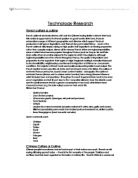Short paper on food in the Chinese Diaspora
Chopsticks
When studying a culture, it is imperative to look through the lens of all aspects that govern the way of life to get a full grasp of the cultural practices. Many studies have been done on religion, government, societal relationships, however food has often been neglected. K.C. Chang, in his introduction to Food and Chinese Culture states, “…sometimes we fail to realize that food is more than just vital. The only other activity that we engage in that is of comparable importance to our lives and life of our species is sex”(3). To say that the study of food and its traditions through a culture is vital to understanding a society is an understatement. Throughout this semester, we have been looking at the historical transformations of the Chinese through their food habits and the role that food plays in their cultural roles. In this short paper, I will be looking at the use of chopsticks in the same light. Just as food can be seen as practical, artistic and in line with Chinese beliefs, I agree the chopsticks popularity in the Chinese culture are also in line with these same characteristics. Through their flexibility in material, their aesthetic value, and adherence to Confucius beliefs, chopsticks can also be analyzed to better understand the culture of the Chinese.
Chopsticks are a central piece to the Chinese culture. Their popularity and widespread use across China have a long and rich history, developing the chopstick into an important Chinese icon. It is believed that the first chopsticks were developed over 5000 years ago in China. The enduring popularity of chopsticks is most definitely linked to the Chinese cooking methods, which have not significantly changed since early time. It has been said that early Asian man would retrieve his food from the fire using long sticks or branches broken from trees. As the population grew and resources became scarce, fuel became a lacking commodity. Because of the lack of material to burn for fire, cooking had to be done as quickly as possible. The food, especially the meat, was cut into very small pieces in order for them to cook faster. This eliminated the need for knives when eating at a table since the food was small enough to put directly into the mouth. Using the sticks that had been used to cook, the early Asian man could pick up the small pieces of food to eat. These “sticks” eventually evolved into the chopsticks we know today.







